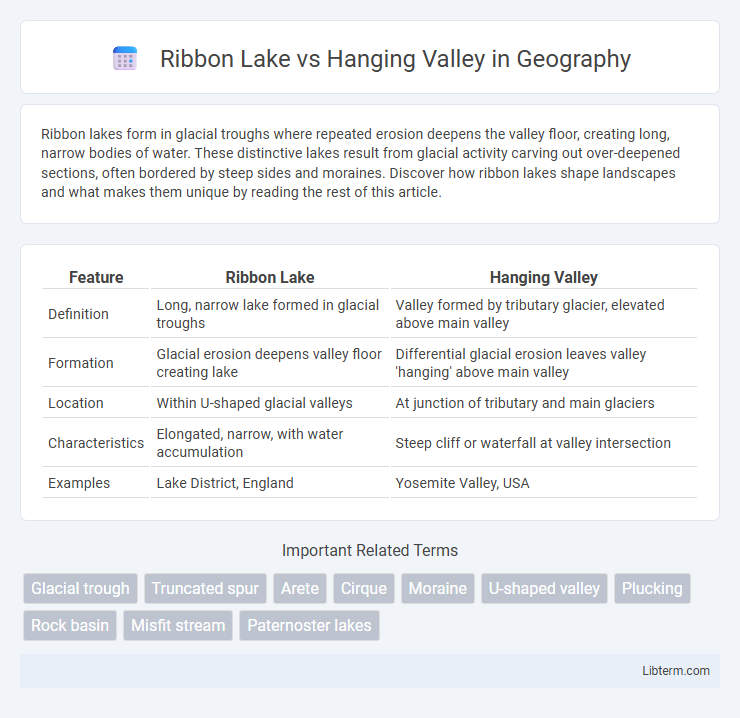Ribbon lakes form in glacial troughs where repeated erosion deepens the valley floor, creating long, narrow bodies of water. These distinctive lakes result from glacial activity carving out over-deepened sections, often bordered by steep sides and moraines. Discover how ribbon lakes shape landscapes and what makes them unique by reading the rest of this article.
Table of Comparison
| Feature | Ribbon Lake | Hanging Valley |
|---|---|---|
| Definition | Long, narrow lake formed in glacial troughs | Valley formed by tributary glacier, elevated above main valley |
| Formation | Glacial erosion deepens valley floor creating lake | Differential glacial erosion leaves valley 'hanging' above main valley |
| Location | Within U-shaped glacial valleys | At junction of tributary and main glaciers |
| Characteristics | Elongated, narrow, with water accumulation | Steep cliff or waterfall at valley intersection |
| Examples | Lake District, England | Yosemite Valley, USA |
Introduction to Ribbon Lake and Hanging Valley
A Ribbon Lake forms in glacial troughs where prolonged ice erosion deepens the valley floor, creating long, narrow lakes with steep sides. Hanging Valleys are elevated valleys formed by tributary glaciers that erode less deeply than the main glacier, often resulting in waterfalls where they meet the main valley. Both features illustrate distinct glacial erosion patterns shaping landscapes during the last Ice Age.
Geological Formation Processes
Ribbon lakes form through glacial erosion, where advancing glaciers deepened pre-existing river valleys, carving narrow, elongated depressions filled with water after the ice retreats. Hanging valleys result from tributary glaciers eroding their valleys less deeply than the main glacier, leaving elevated valleys suspended above the main valley floor, often creating waterfalls. Both features illustrate the differential glacial erosion processes shaping mountainous landscapes during ice ages.
Key Characteristics and Features
Ribbon lakes form in glacial troughs and are long, narrow, and deep, often created by glacial erosion over softer rock; they are characterized by their elongated shape and significant depth. Hanging valleys occur where smaller tributary glaciers met main glaciers, resulting in a valley that is elevated above the main valley floor, frequently marked by waterfalls. The primary distinction is that ribbon lakes are water-filled glacial troughs, while hanging valleys result from differential glacial erosion and typically form elevated streams or waterfalls.
Differences in Valley Shapes
Ribbon lakes are elongated, narrow bodies of water found in glacial troughs, formed by differential erosion where softer rock has been worn away more than surrounding harder rock. Hanging valleys are elevated tributary valleys that end abruptly above the main valley floor, created when smaller glaciers join a larger glacier and are eroded less deeply. The key difference lies in their shapes: ribbon lakes are long and deep depressions filled with water, while hanging valleys are elevated, steep-sided valleys that often feature waterfalls where they meet the main valley.
Examples of Ribbon Lakes Worldwide
Ribbon lakes, elongated and narrow glacial lakes formed in over-deepened valleys, are exemplified by Lake Windermere in England's Lake District and Loch Morar in Scotland, both showcasing typical ribbon lake morphology. These lakes contrast with hanging valleys, which are elevated tributary valleys often featuring waterfalls, such as the Bridalveil Fall in Yosemite National Park, USA. Ribbon lakes demonstrate glacial erosion's impact on valley deepening, while hanging valleys illustrate differential glacial erosion and valley elevation changes.
Notable Hanging Valleys Around the Globe
Hanging valleys form when tributary glaciers carve valleys at a higher elevation than the main glacial trough, resulting in steep drops that often feature waterfalls. Notable hanging valleys include Yosemite Valley's Bridalveil Fall in California, the Svinafellsjokull glacier area in Iceland, and the Langdale Valley in the Lake District, England. These dramatic landscapes contrast with ribbon lakes, which are long, narrow lakes formed in glacial troughs and found in regions like the English Lake District and the Scottish Highlands.
Ecological Importance and Biodiversity
Ribbon lakes, formed in glacial troughs, serve as crucial freshwater habitats supporting diverse aquatic species and maintaining regional biodiversity. Hanging valleys, perched above main glacial valleys, provide unique microclimates fostering specialized plant and animal communities not found in lower valley floors. Both landforms contribute significantly to ecological connectivity and habitat diversity within glaciated landscapes.
Human Activities and Utilization
Ribbon lakes, often found in glacial valleys, are commonly utilized for recreational activities such as fishing, boating, and tourism, fostering local economies. Hanging valleys, with their steep drops and waterfalls, attract hikers and climbers seeking scenic views and adventure, contributing to outdoor tourism industries. Both landforms influence human settlement patterns by providing natural resources and aesthetic value, shaping cultural and economic development in glaciated regions.
Challenges and Environmental Concerns
Ribbon lakes face challenges from sediment accumulation and water pollution due to agricultural runoff, threatening aquatic habitats and biodiversity within the elongated depressions formed by glacial erosion. Hanging valleys often experience increased erosion and instability along steep slopes, exacerbated by climate change-induced shifts in precipitation patterns and glacial melting, leading to habitat disruption and landslide risks. Both landforms require careful environmental management to mitigate impacts from human activities and natural processes affecting their ecological balance and geological stability.
Summary: Comparing Ribbon Lake and Hanging Valley
Ribbon lakes form in glacial troughs where deep erosion creates elongated water-filled basins, characterized by their long and narrow shape. Hanging valleys occur when smaller tributary glaciers join a main glacier, leaving behind elevated valleys that often result in waterfalls. The primary difference lies in their formation and topography: ribbon lakes occupy glacial trough floors, while hanging valleys are elevated above the main valley floor.
Ribbon Lake Infographic

 libterm.com
libterm.com